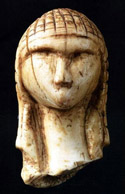Anthropology, Department of

Department of Anthropology: Faculty Publications
Document Type
Article
Date of this Version
2008
Citation
American Antiquity, 73(1), 2008, pp. 83-102
Abstract
Despite ranking at the low end of the continuum in net caloric benefit relative to other foods, small seeds assumed great dietary importance in many parts of the world, including western North America. In a series of publications, Adovasio (1970a, 1974, 1980, 1986) argued that coiled basketry technology was invented in the eastern Great Basin during the early Holocene as a specialized food-processing technique. Coiled baskets are indeed useful for collecting and processing seeds, but it does not necessarily follow that they were originally designed for this purpose. A whole basket recently discovered at Cowboy Cave in southeastern Utah returned an AMS radiocarbon assay of 7960 ? 50 B.P, making it currently the earli est directly dated coiled basket from the Americas. This basket is not a parching tray and. likely had nothing to do with har vesting seeds. We discuss the implications of this find with regard to tracking the temporal spread of coiled basketry technology in western North America and the role of coiled and twined forms in the initiation of small seed exploitation. Coiled and twined baskets for small seed processing may result from reconfiguration of existing technologies to create novel forms suited to a new food exploitation strategy.
Apesarde localizarse en la parte inferior del rango calorico relativo a otros alimentos, pequehas semillas asumieron unpapel de gran importancia dietetica en muchas partes del mundo, incluyendo el oeste de Norteamerica. En una serie de publica ciones, Adovasio (1970a, 1974, 1980, 1986) sehala que la tecnologia de cesteria tejida en forma de espiralfue inventada en la parte oriental de la Gran Cuenca norteamericana durante el Holoceno temprano especificamente para secar semillas. De hecho, las cestas en espiral son utiles para el procesamiento de la semilla, pew no necesariamente fueron originalmente dis ehadas para este proposito. Recientemente, una cesta completafue descubierta en una cueva (Cowboy Cave) en el sudeste de Utah que arrojo un andlisis de radiocarbono de AMS 7960 ? 50 B.P, haciendola actualmente la cesta tejida en espiral mas antigua analizada directamente en las Americas. Esta cesta no cumplia una funcion para secar ni probablemente tampoco para cosechar semillas. Hablamos de las implicaciones de este hallazgo en relacion con el seguimiento de la expansion tem poral de la tecnologia cestera tejida en espiral en el suroeste estadounidense, y los papeles de estas formas espirales y tren zadas en el inicio de la explotacion de pequehas semillas. Cestas tejidas en espiral y trenzadas para el procesamiento de semillas pequehas podrian haber resultado de la reconfiguracidn de tecnologias ya existentes para crear nuevas formas estrategicas en la explotacion de nuevos alimentos.


Comments
Copyright (c) 2008 by the Society for American Archaeology. Published by Cambridge University Press. Used by permission.